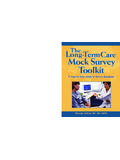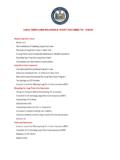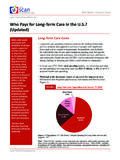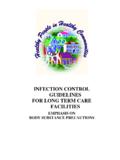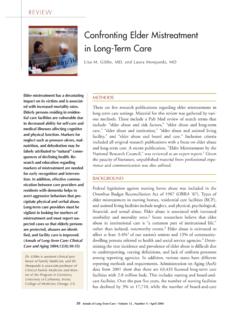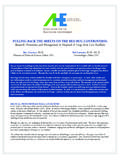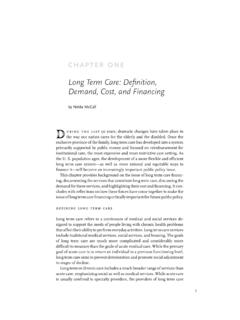Transcription of SUGGESTED EMERGENCY PLANNING CHECKLIST FOR …
1 DEPARTMENT OF HEALTH AND HUMAN SERVICES CENTERS FOR MEDICARE & MEDICAID SERVICES Survey & Certification EMERGENCY Preparedness for Every EMERGENCY Note: Some of the recommended tasks may exceed the long -term care facility s Federal regulatory requirements. September 2007 Page 1 EMERGENCY PLANNING CHECKLIST RECOMMENDED TOOL FOR PERSONS IN long -TERM care FACILITIES & THEIR FAMILY MEMBERS, FRIENDS, PERSONAL CAREGIVERS, GUARDIANS & long -TERM care OMBUDSMEN Part I: For long -Term care Residents, Their Family Members, Friends, Personal Caregivers, & Guardians Target Date Date Completed EMERGENCY Plan: Prior to any EMERGENCY , ask about and become familiar with the facility s EMERGENCY plan, including: 3 Location of EMERGENCY exits 3 How alarm system works and modifications for individuals who are hearing and/or visually impaired 3 Plans for evacuation, including.
2 How residents/visitors requiring assistance will be evacuated, if necessary How the facility will ensure each resident can be identified during evacuation ( , attach identification information to each resident prior to evacuation) Facility s evacuation strategy Where they will go How their medical charts will be transferred How families will be notified of evacuation 3 Will families be able to bring their loved one home rather than evacuating, which is often less traumatic than a move to a new facility? 3 How family members can keep the facility apprised of their location and contact information ( , address, phone number, e-mail address), so the facility will be able to contact them, and family members will be able to check with the facility to meet their loved one following an EMERGENCY 3 How residents and the medicines and supplies they require will be prepared for the EMERGENCY , have their possessions protected and be kept informed during and following the EMERGENCY 3 How residents (if able) and family members can be helpful (for example, should family members come to the facility to assist?)
3 3 How residents, who are able, may be involved during the EMERGENCY , including their roles and responsibilities. Note: It is important for staff to know each resident personally, and whether involving him/her in the EMERGENCY plan will increase a sense of security or cause For example, residents may have prior work or personal experience that could be of value (health care , EMERGENCY services, military, amateur ham radio operators, etc.) Provide the opportunity for residents to discuss any fears and what actions may help to relieve their anxiety ( , a flashlight on the bed, water beside the bed, etc.). DEPARTMENT OF HEALTH AND HUMAN SERVICES CENTERS FOR MEDICARE & MEDICAID SERVICES Survey & Certification EMERGENCY Preparedness for Every EMERGENCY Note: Some of the recommended tasks may exceed the long -term care facility s Federal regulatory requirements.
4 September 2007 Page 2 Helping Residents in a Relocation: SUGGESTED principles of care for relocated residents include: 3 Encourage the resident to talk about expectations, anger, and/or disappointment 3 Work to develop a level of trust 3 Present an optimistic, favorable attitude about the relocation 3 Anticipate that anxiety will occur 3 Do not argue with the resident 3 Do not give orders 3 Do not take the resident s behavior personally 3 Use praise liberally 3 Be courteous and kind 3 Include the resident in assessing problems 3 Encourage family participation 3 Ensure staff in the receiving facility introduce themselves to residents Part II: For long -Term care Ombudsmen Targeted Date Date Completed State Ombudsman Responsibilities: 3 Become generally familiar with state EMERGENCY plans pertinent to long -term care facilities, including the state or federal agency that may be established to serve as a clearinghouse for facility evacuations: know the name, telephone number and e-mail of the person to whom long -term care facility evacuations and evacuees names should be reported.
5 If no clearinghouse has been established, advocate for one. 3 At least annually, ensure that all regional ombudsman coordinators and local ombudsmen and/or representatives read, are familiar with and have the opportunity to discuss resources, such as the two recommended CMS EMERGENCY preparedness checklists pertaining to long -term care facilities: the CMS EMERGENCY Preparedness CHECKLIST Recommended Tool for Effective Health care Facility PLANNING and this CMS EMERGENCY PLANNING CHECKLIST Recommended Tool for Persons Living In long -Term care Facilities, Their Family Members, Friends, Personal Caregivers, Guardians, & long -Term care Ombudsmen. 3 Maintain at home and office hard copies of current regional ombudsman contact information, including cell phones. 3 Prior to an anticipated disaster, if the state ombudsman program has regional coordinators and/or other program representatives in the areas likely to be affected, call them to make sure they have assigned representatives to carry out the responsibilities listed in the section below pertaining to local ombudsman programs.
6 3 Immediately following a disaster, contact regional ombudsman coordinators/representatives in the affected areas to provide support and DEPARTMENT OF HEALTH AND HUMAN SERVICES CENTERS FOR MEDICARE & MEDICAID SERVICES Survey & Certification EMERGENCY Preparedness for Every EMERGENCY resources, as needed and feasible. Note: Some of the recommended tasks may exceed the long -term care facility s Federal regulatory requirements. September 2007 Page 3 Regional Ombudsman Coordinator & Representative Responsibilities (for states with regional/local ombudsman programs and/or representatives) Prior to any EMERGENCY , ombudsmen: 3 Become generally familiar with the local EMERGENCY plans and the roles of local, county and state agencies in a disaster, especially as pertaining to long -term care facilities. 3 Read and become familiar with EMERGENCY plans of facilities in the region for which the regional program has responsibility.
7 If a state or regional clearing house for evacuations has been established, know the agency, phone number and e-mail where facility evacuations will be reported. 3 Maintain, at home and office, hard copies of current contact information for facilities, other ombudsmen and appropriate agencies, especially the local EMERGENCY management agency. Prior to an anticipated EMERGENCY and following an EMERGENCY : 3 The regional ombudsman program coordinator assigns a representative to check on each facility covered by the program and reviews the responsibilities listed below with representatives assigned to facilities. 3 Assigned representatives check on assigned facilities to assure that residents rights are protected prior to, during and after evacuation and provide information about conditions and any evacuation to the regional ombudsman coordinator; regional coordinator provides information to the state ombudsman office.
8 Exception: when the ombudsman lives in an area under mandatory evacuation; however, if possible, the ombudsman should contact the facility by telephone, even if the area is under evacuation order. (Some states may have other specific procedures in place which ombudsman representatives would be required to follow.) 3 Ombudsman representatives visit residents as soon as possible after the disaster, whether they have been sheltered in the facility or transferred to another location. (If they have been transferred out of the region, state ombudsman and regional coordinators coordinate visitation by ombudsman representatives in the receiving region.) Discuss and record their immediate status/needs. If the state and local ombudsman coordinator decide a form is needed, use appropriate form to record information (a sample form is attached) and send a copy of the form to whomever they specify.
9 Take urgent action to help obtain the resources and assistance residents need to be safe and, if they have been evacuated, find their loved ones and relocate to an area/facility or other setting of their preference. (Note: the ombudsman is not responsible for providing resources but instead should be aware of available resources and work to ensure they are provided to residents.) 3 Track, if possible, the impact of the disaster on the residents 3 Determine whether the facility has reported the names and destination of any evacuated residents to the clearinghouse (if state or region has DEPARTMENT OF HEALTH AND HUMAN SERVICES CENTERS FOR MEDICARE & MEDICAID SERVICES Survey & Certification EMERGENCY Preparedness for Every EMERGENCY established a clearinghouse), and is prepared to handle transfer trauma and support facility staff in handling resident trauma.
10 As provided in Part I, above, SUGGESTED principles of care for the relocated residents include: Note: Some of the recommended tasks may exceed the long -term care facility s Federal regulatory requirements. September 2007 Page 4 Encourage the resident to talk about expectations, anger, and/or disappointment Work to develop a level of trust Present an optimistic, favorable attitude about the relocation Anticipate that anxiety will occur Do not argue with the resident Do not give orders Do not take the resident s behavior personally Use praise liberally Be courteous and kind Include the resident in assessing problems Encourage staff in the receiving facility to introduce themselves to residents Encourage family participation 3 Counsel residents about their rights to: Be informed regarding the status of the relocation Be provided information on alternative living arrangements and the options available Be assessed for eligibility for funding and supports to safely return to live in their home or community Visit other facilities to help them better decide where to live Seek representation by an ombudsman or other representative/advocate available in the area Expect to receive adequate care and treatment services during the relocation Meet with the facility staff to express any concerns Seek a review of any relocation changes with which they disagree Expect that their rights, while a resident of any facility, will not be violated (Note: Adapted from WI Ombudsman Program brochure for residents of facilities scheduled for closure) Note.










